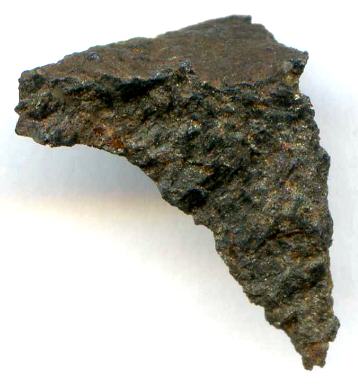L4

Found 1916
26° 41′ N., 80° 48′ W. Fragments weighing ~1 kg were brought up in a net about three-quarters of a mile from the shore of Lake Okeechobee. This is one of only four meteorites found in Florida, all of them of the stony type. The above specimen is a 0.87 g crusted fragment.
Due in part to the intense temperature and moisture conditions in the state of Florida, only four meteorites have been found there to date, in addition to two recovered falls. Besides Okechobee, an H4 stone weighing 502 g was plowed up in
Eustis, a 41.8 kg H5 stone was found in
Bonita Springs, and a 10.9 kg H5 stone was found near
Grayton Beach. In 2004, November 8 at 6:15 P.M., Orlando resident Donna Shuford heard a
meteoriteWork in progress. A solid natural object reaching a planet’s surface from interplanetary space. Solid portion of a meteoroid that survives its fall to Earth, or some other body. Meteorites are classified as stony meteorites, iron meteorites, and stony-iron meteorites. These groups are further divided according to their mineralogy and Click on Term to Read More bounce off her car and hit the side of her house. Fragments composing an ~180 g
eucriteMost common type of achondrite meteorite and a member of the HED group. Eucrites are basalts composed primarily of pigeonite and anorthite (An60-98). Eucrites have been placed into three subgroups based on mineralogical and chemical differences. • Non-cumulate eucrites represent the upper crust that solidified on a magma ocean after Click on Term to Read More were recovered. In 2016, January 24 at 10:27 A.M., numerous eyewitnesses observed a bright
fireballA fireball is another term for a very bright meteor, generally brighter than magnitude -4, which is about the same magnitude of the planet Venus as seen in the morning or evening sky. A bolide is a special type of fireball which explodes in a bright terminal flash at its end, often with visible fragmentation. Click on Term to Read More over northern Florida near the Osceola National Forest. Utilizing
radar images from several stations, a group of hunters successfully plotted the
fallMeteorite seen to fall. Such meteorites are usually collected soon after falling and are not affected by terrestrial weathering (Weathering = 0). Beginning in 2014 (date needs confirmation), the NomComm adopted the use of the terms "probable fall" and "confirmed fall" to provide better insight into the meteorite's history. If Click on Term to Read More site and recovered 8 stones over many weeks having a combined weight of 1,099.6 g. The L6
chondriteChondrites are the most common meteorites accounting for ~84% of falls. Chondrites are comprised mostly of Fe- and Mg-bearing silicate minerals (found in both chondrules and fine grained matrix), reduced Fe/Ni metal (found in various states like large blebs, small grains and/or even chondrule rims), and various refractory inclusions (such Click on Term to Read More fell within a
forested wetlands region delimiting a
strewn field of approximately 5 miles × 1 mile.
Although the correct spelling of this Florida lake location is Okeechobee, the incorrect spelling initially used in the
Catalogue of Meteorites of The Natural History Museum, London, as well as in the Meteoritical Bulletin Database is followed here. The correct spelling of this
findMeteorite not seen to fall, but recovered at some later date. For example, many finds from Antarctica fell 10,000 to 700,000 years ago. Click on Term to Read More location (more accurately, the nearest post office to the find location) has been included as a synonym in the
Meteoritical Bulletin Database.







